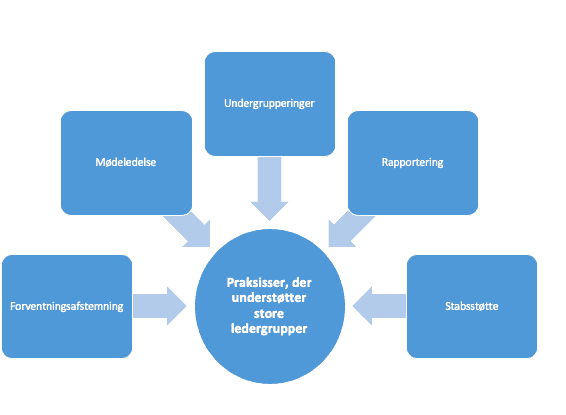Both practice and research suggest that the size of leadership teams in itself carries a risk of efficiency loss and poorer performance. Although there is generally a negative correlation between size and performance, large management teams can be effective and produce good results. But it requires a special effort. The general rule of thumb suggests that somewhere between 5-7 people is the optimal size. But what do you do when you have more than 7 leaders in your management teams? Below we meet Peter, who faces this very challenge.
A well-functioning mega management team
Peter is a manager in the newly organized social area, which has just undergone a major reorganization. This means that Peter now has 12 department managers in direct report and has to lead a large management team. For the first few months after the reorganization, Peter continues to work with the new management team as he did with the previous - much smaller - management team. However, Peter quickly realizes that something is wrong. Many of the managers fail to show up to management team meetings or attend silently and disinterestedly. In addition, many of the managers complain that they are under extreme pressure and that the reorganization has only given them even more to do. Peter finds that managers are completely silent when it comes to strategic discussions about what they need to succeed together to drive the social area forward.
After thinking about the situation for a month, Peter realizes that he can't run the new management team in the same way as the previous one. The new management team is twice as big, much more diverse and has much more strategic responsibility than before. Peter engages in a dialog with his leadership team about why the current way of working together doesn't work in the new reality they find themselves in. Peter decides with the rest of the management team members that if they are to succeed as a management team with joint management of the social area, they need to:
- Establish a common direction and a clearly defined shared purpose for the leadership team so everyone can clearly see themselves in the leadership team.
- Develop common guidelines and frameworks for good collaboration in the management team so that everyone agrees on how to act in the management team.
- Clearly align roles, responsibilities and tasks between both Peter and the department heads, as well as the department heads and their subordinate managers. After dialog in the management team, it becomes clear that the strategic leadership skills of the department managers need a significant boost, and that they also need to become better at delegating tasks to their subordinate managers.
- Establish meaningful sub-groups within the leadership team so that not everything needs to be brought into the big group, but many discussions can be held in smaller forums instead.
As illustrated in the case of Peter, it is important to work with systematics and practices that support a large management team to be well-functioning and effective. Practical experience as well as research shows that leaders of large management teams can benefit from working with the following five areas to support the management team to be well-functioning and effective:

LEADERSHIP IN PRIVATE COMPANIES
Get a tailored program that solves the challenges you face now - and in the future
We help you drive business results by developing your leadership capacity, speed and flexibility. We do this by drawing on new research-based knowledge of what works, combined with many years of experience with results-driven leadership in other private and public companies.
Alignment of expectations
Managers of large management teams have a special task in supporting and organizing the work of the management team in a way that takes into account that 1-1 management is not possible or particularly extensive. With a large number of managers in reference, you don't have the same opportunity to be close to the managers' task performance and professional development. Some of this must be handled elsewhere, for example in smaller groups within the management team with special responsibility for supporting and developing each other. At the same time, the manager must be able to react quickly when things get out of hand and problems cannot be handled by the managers themselves. To succeed in this requires a clear alignment of expectations with your managers around roles and responsibilities.
This alignment of expectations is just as crucial from the top down, with many managers reporting to their CEO. Unrealistic expectations from above that the boss is close to all their managers and has insight into all the details of their units can cause even the most skilled manager to break their neck. Managing a large management team calls for more systems management than 1-1 management, but if expectations are unrealistic from the top, it's hard to succeed.
Meeting management
A key discipline in the management of large management groups is sharp meeting management with an eye for which topics are suitable for discussion in the large group and which should be discussed elsewhere. The more members, the less speaking time per person and thus also the opportunity to include the participants' resources in the discussions. Therefore, discussions should typically be of a strategic nature with relevance to all managers or topics that everyone can benefit from. When there are more participants, there is also an increased risk of the process getting off track because there are different perceptions of the topic being discussed or the process to be followed. This calls for very strict process management from the manager and some clear steps in the discussions and decision-making processes.
Subgroups
As the leader of a large management team of perhaps 12-20 managers, it's crucial to make use of sub-groupings. Put managers into subgroups of 3-4 people based on task context, geography or any other principle that makes sense for the management team. These groups then act as the manager's individual sparring room, where topics that aren't covered in the larger management team meetings can be discussed. In addition, the manager can supplement these groups with group development conversations if there is no time for individual sparring with each manager. The purpose of the sub-groups is to meet to discuss local issues, discuss the implementation of strategies and new initiatives in their local perspective and support each other's development.
Reporting
When managing a large group of managers, streamlined and systematic reporting is needed to maintain an overview and respond to potential challenges. You can create a template of what you want managers to report on and do this via a simple red, yellow, green visualization. These reports are discussed by the managers themselves in the subgroups, where they also work out how to address challenging areas. In addition, this provides the basis for a group report to the leader of the management team, which gives an overview of whether something requires the manager's attention. Some typical areas to include in such reporting are:
- What about professional quality?
- How is the economy?
- What does sickness absence and well-being look like in the area?
- Are customers satisfied with the services?
- How is the implementation of the most important initiatives progressing?
- How is efficiency and productivity?
Staff support
One final area that can improve the work of large leadership teams is the active use of staff support. For example, an internal consultant can be used to take minutes, help with time and agenda management, help keep the process and discussions on track, provide an "outside-in" perspective on the leadership team's discussions, and help the leadership team prepare for its meetings and follow up on its decisions.
Sources
- Bang, H., Midelfart, N., Molly-Søholm, T. & Elmholdt, C. (2015) Effektive ledergrupper - for bedre udvikling, implementering og tværgående sammenhæng, Dansk Psykologisk Forlag
- Green, R.T. (2018) "Effective leadership teams: Black holes or guiding stars?", Offentlig Ledelse, November
- Hackman, J.R. (2002) Leading teams. Setting the stage for great performance, Boston: Harvard Business school press
- Molly-Søholm, T., Petersen, E. and Bendixen, M. (2016) "Sådan leder du en stor ledergruppe", HR chefen april, Dansk HR



